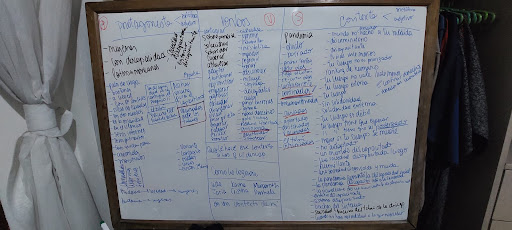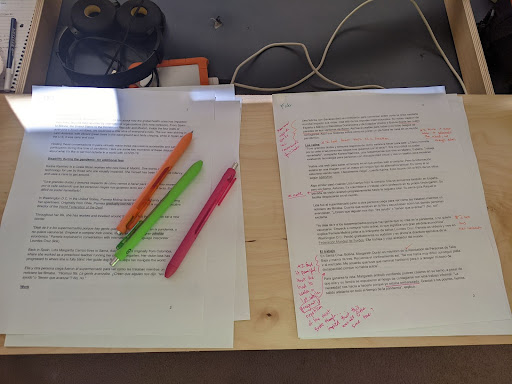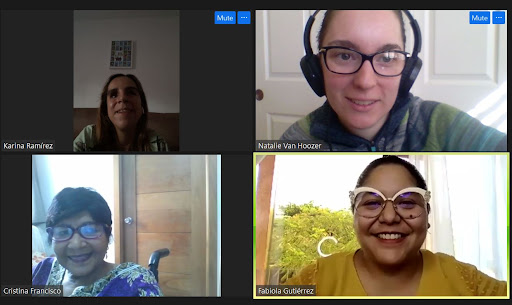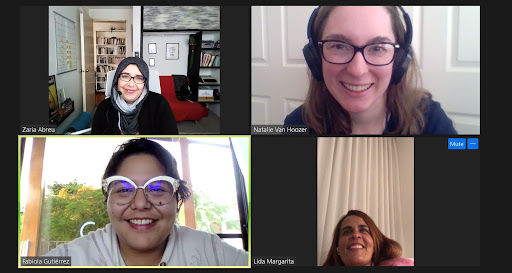
Screenshot of one of the facilitated conversations. The participants were Pamela Molina from Washington, D.C. (top left) and Margareth Durán Vaca from Santa Cruz, Bolivia (bottom left), sign language interpreter Lourdes Cruz from Santa Cruz, Bolivia (top right), and journalists Natalie Van Hoozer (top center) and Fabiola Gutiérrez (bottom right).
“Persisting in the Pandemic: Conversations between Latinas with disabilities” is a project that highlights the first-person stories of Latin American women with disabilities. During facilitated conversations, this diverse group of women talked with each other about how the coronavirus pandemic has impacted their daily lives. This article details why we decided to do this journalism project through facilitated conversations, as well as the logistics for using this technique.
This project includes three other articles as part of the series: one providing an overview of the rights of women with disabilities in Latin America during the pandemic, another about what their lives are like outside the house, and the third on how the pandemic has changed their lives inside their homes.
How we created the project
This reporting project was produced collaboratively by independent, bilingual journalists Fabiola Gutiérrez in Bolivia and Natalie Van Hoozer in the United States. As recipients of the ICFJ-Hearst Foundations Global Health Crisis Reporting Grant, we received mentorship and editorial support from Mexican journalist Priscila Hernández Flores, who specializes in reporting on human rights with an emphasis on diversity and disability. The grant also provided financial support from the International Center for Journalists and the Hearst Foundations. The publication of this reporting project is possible thanks to Global Voices.
Instead of using the traditional model of a journalist interviewing someone, this project focuses on women with disabilities having conversations with each other, with journalists facilitating the discussion. We invited the six Latina women featured in this project to participate in order to reflect a variety of lived experiences in each interview. They talked to each other in pairs during three separate virtual conversations.
We matched conversation partners based on the participants having different types of disabilities and different backgrounds, as some are immigrants and others are mothers and/or social leaders. When the conversation included a deaf person, we arranged for the participation of sign language interpreter Lourdes Cruz, who used International Sign Language, so that all interviewees could fully express themselves. We also took into account that each participant lives in a different location, either in the Western Global North (Spain and the United States) or in the Latin American Global South (Mexico, the Dominican Republic and Bolivia).

The whiteboard of journalist Fabiola Gutiérrez, who is based in Santa Cruz, Bolivia, showcases a brainstorming exercise she did with her colleagues to decide the name of the project. Photo from ‘Persisting in the Pandemic: Conversations between Latinas with disabilities.’
This style of pairing participants allowed the women to create a safe space together. The dynamic established with the facilitated conversation process also helped them to relate to each other’s pandemic experiences, while at the same time letting them be curious about and appreciate their differences. Inspiration to break away from the standard interview format comes from the model used by StoryCorps. Specifically, the One Small Step initiative was a key reference for us, as the program is designed for people with different political views to interact with one another.
Project co-author Natalie Van Hoozer had worked previously on One Small Step and recognized the storytelling potential of facilitated conversations. As a team, we believe in creating journalism that inspires empathy and solidarity.
How we facilitated conversations
First, we created a list of potential conversation candidates, who we then invited for brief, half-hour individual video calls with one of us. This initial meeting was designed to tell each potential participant about the project, answer their questions, check that they were interested, and had the right conditions to take part, such as a quiet and well-lit space, and a good internet connection. Some candidates we talked to decided not to participate in a full conversation because they became sick with COVID-19 or had other health issues.

The desk and papers of journalist Natalie Van Hoozer in Reno, Nevada, USA. Project mentor Priscila Hernández Flores guided Van Hoozer and Fabiola Gutiérrez through the process of editing and structuring the stories, which involved identifying findings from the facilitated conversations and reading story drafts out loud. Photo from the project ‘Persisting in Pandemic: Conversations of Latinas with Disabilities.’
Once the conversation participants were confirmed, we created a script for each 90-minute conversation. This script included opening remarks, ground rules, potential questions for each pair of interviewees, and a final reflection. We followed this guide to ensure the interviews were consistent. Having this detailed structure also helped us familiarize the participants with this new interview style, as well as establish healthy boundaries related to telling personal stories to someone you have just met.
All of the conversations were conducted on Zoom, and we invited each participant to start by introducing herself to her conversation partner. Taking time for this step was a key component of this project, as it allowed participants to determine how they wanted to identify with their disability for the discussion. Giving the interviewees control of the conversation was fundamental to encouraging natural, flowing conversations that let the participants choose how they wanted to tell their stories. Most importantly, it allowed the women to determine how much or how little they would discuss their disabilities.

A screenshot from the facilitated conversation with participants Karina Ramírez in Madrid, Spain (top left) and Cristina Francisco in Santo Domingo, Dominican Republic (bottom left) and journalists Natalie Van Hoozer (top right) and Fabiola Gutiérrez (bottom right).
During these video calls, we invited participants to discuss four main topics: health, work, life at home, and caregiving. The following are some of the key questions we suggested for each pair to ask one another:
- When did you first hear about the coronavirus?
- Did your disability create any additional fear for you during the pandemic?
- What have been reliable sources of information for you during the global health crisis?
- Have you been able to find information about COVID-19 that is accessible?
- Are there any experiences related to your work, housing, or situation related to accessing food that you would like to tell me about in order to better understand your life, especially during the pandemic?
- With the pandemic, how have your responsibilities at home changed? Do you have more or less work, time, or fatigue?
When we invited participants to ask each other any questions that came to mind during their chat, they told each other about their day-to-day lives. They talked about everything, from caring for children and family when they themselves had COVID-19, to how information about the pandemic was not accessible for the visually impaired.
Gutiérrez took on the role of facilitator, welcoming the participants and guiding them through the conversation process. She also got the discussion started and concluded the interview. Van Hoozer acted as the interview producer, taking detailed notes and watching the length of the discussion. Depending on the way each conversation went, Van Hoozer provided Gutiérrez with ideas on how to redirect the dialogue. Van Hoozer also typed each question for the interviewees in the Zoom chat, to make the questions as accessible as possible.

A screenshot of the conversation facilitated between Zaría Abreu Flores in Mexico City (top left) and Lida Margarita Carriazo in Sama, Asturias, Spain (bottom right) by journalists Natalie Van Hoozer (top right) and Fabiola Gutiérrez (bottom left).
Why use this methodology?
Throughout all the conversations, asking each other direct questions allowed the participants to put themselves in each other’s shoes. What resulted was a rich, narrative-driven discussion that provided us with a wealth of information for our reporting. We also wanted to give these women a conversation platform that allowed them to dignify their experiences, especially given the fact that the day-to-day life of women with disabilities in Latin America is rarely reported in the media. For this reason, we chose to provide these women with a space for dialogue that would also allow them to get to know each other. Hopefully, the relationship they developed during the conversation process will continue beyond this project.
The women who took part in these conversations listened to and trusted each other. This trust allowed them to be vulnerable as they revealed their personal challenges. They shared moments of hope and sadness, and even laughed together. Navigating all these emotions is part of their experience persevering through the pandemic.
To show how the interviewees experienced the facilitated conversation methodology, here is an excerpt from the conversations:
“I feel that, in a space like this, we find commonalities with each other. Regardless of whether we have the same disabilities, we share problems related to accessibility, and even life experiences. Because of this caring environment, I think it’s so easy to let go and feel understood when we share our stories,” said Zaría Abreu Flores, who lives in Mexico.
Lida Margarita Carriazo, who is originally from Colombia and now lives in Spain, replied: “I mean, we end up smiling and everything, even though we’re talking about really hard, really difficult situations.”
To learn more about these women and their conversations, you can read the other three articles in this series about their experiences inside and outside their homes in times of the coronavirus, as well as a piece providing context about the rights of women with disabilities in Latin America during the pandemic.








